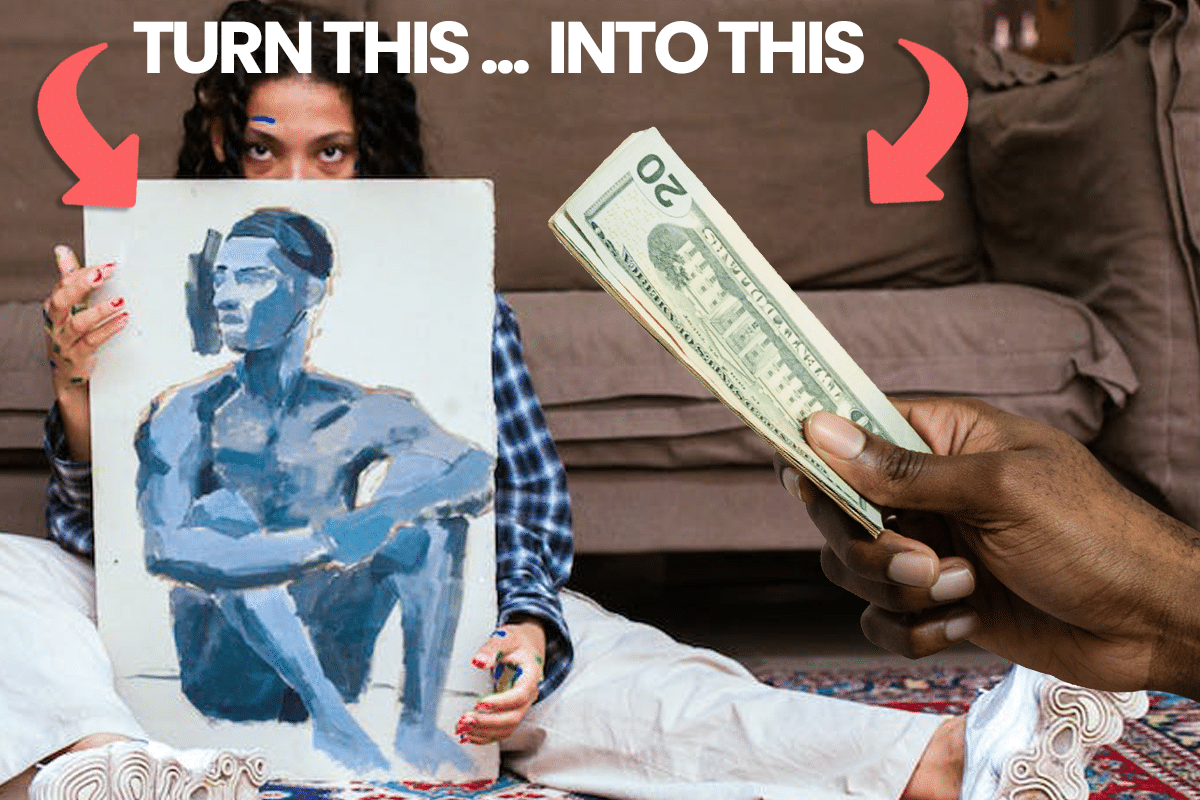Making money as an artist is totally possible, but it requires plenty of hard work and a solid plan for the long haul.
In this article, I’m going to share everything I’ve learned about selling your art online, attracting new clients, and more to help you increase your income as an artist or creative. Having spent years as a creative artist myself, I’ve gathered all my best tips and insights into this article.
14 Top Ways to Earn as an Artist
If you’re passionate, skilled, and committed, yet unsure how to earn money as an artist, know that there are many paths open to you—and you don’t have to stick to just one. By thinking creatively, you can develop several income streams. Whether you work in art part-time or as a full-time freelancer, numerous opportunities exist to profit from your art. Here are some of the most effective methods I’ve discovered for artists to make a living:
Direct Sales to Consumers
Gone are the days when selling art meant needing an agent or gallery exhibitions. In today’s digital world, selling your art directly has become much simpler. Below, I’ve listed some top strategies to get you started.
Money Note: If an extra $1K–$5K/month would change your 2026 goals (debt, savings, travel, freedom), you’ll want to catch this: free live workshop from a freelancer who’s earned $4M+ online. No fluff. No gimmicks. A real roadmap. 👉 Watch the training or save your seat here »
- Sell Your Original Works: Whether it’s paintings, sculptures, decorative items, or jewelry, you can sell them online through various websites or e-stores. While a personalized, fancy website can work wonders if you have an existing audience or marketing resources, newcomers might find more success on established online art marketplaces, which draw in thousands of potential buyers.
- Offer Prints: Selling original art can fetch high prices, but once sold, that’s it—you need to create more. Prints, however, allow you to sell more copies at lower prices, creating a steady revenue stream. Numerous online platforms offer print-on-demand services, reducing upfront costs.
- License Your Art for Stock Websites: Artists like graphic designers, illustrators, photographers, and videographers can license their work to stock websites, earning passive income. Stock sites have quality and content guidelines, so ensure your work is high-quality, broadly appealing, and meets their standards.
- Take on Private Commissions: Commissions involve creating custom art for clients, who will provide some direction regarding size, colors, and other preferences. This can range from street art to murals, offering another income avenue.
- Use Crowdfunding: Platforms like Patreon, Kickstarter, and Indiegogo allow you to gather financial support from your fans. Offering various incentives can help attract a wide supporter base.
Teaching and Consulting
If you have experience, you can guide other aspiring artists. Nowadays, many people prefer online courses or webinars, offering a great opportunity for digital teaching and consulting.
- Host Online Classes or Workshops: Setting up an online course or workshop might seem daunting at first, but platforms like Skillshare make it easier to share your knowledge.
- Provide Tutorials: If you’ve built a following through blogging or social media, selling tutorials in various formats can be a lucrative step.
- Start a Blog: A blog can serve as a powerful marketing tool, attracting clients and building your authority in your field. Platforms like WordPress simplify the process.
- Create and Sell an eBook: For bloggers, publishing an eBook is a natural next step, especially if you’ve already established a trusting audience.
- Offer Coaching and Mentoring: Sharing your experiences through coaching or mentoring can be fulfilling and profitable, especially once you’ve made a name for yourself in blogging or teaching.
- Provide Consulting and Art Direction: With your expertise, you can offer valuable advice on creative projects and artistic direction to individuals and companies.
Working in the Art Industry
- Join Online Marketplaces or Galleries: Working with these platforms can provide insight into the art world and open new opportunities.
- Contribute to Magazines and Blogs: Writing articles, taking photos, or directing art for publications can not only earn money but also expand your network and visibility.
- Apply for Art Grants and Residencies: Institutions like universities and museums offer funding to support artists, presenting significant opportunities for those with strong portfolios and compelling proposals.
15 websites to sell your art online
For those looking to learn how to make money as an artist, there are several online art marketplaces to sell your work on and different ways to do it — only a small sample is listed here. I recommend you do your own thorough research to see which is the best fit for you.
These websites and platforms will offer everything you need to start selling as soon as you upload your pieces, although all charge a commission or an initial fee.
Painters, Illustrators, Sculptors, Photographers
1. Singulart
Singulart is a digital gallery showcasing the creations of over 12,000 artists to a vast audience of over 3 million collectors. This exposure comes through various channels like newsletters, digital marketing efforts, engaging editorial pieces, and a strong presence on social media platforms. Artists who join Singulart gain access to a specialized Creator Care Team. This team offers personalized support and guidance through every phase of the process, including shipping logistics and navigating administrative tasks.
2. Saatchi Art
Boasting nearly 250,000 monthly page views, over 2.3 million social media followers, and a diverse community of 94,000 artists from across the globe, this platform stands out as one of the leading online galleries. Here, artists can market and sell their paintings, drawings, prints, photographs, and sculptures. The gallery facilitates shipping, operates on a non-exclusive policy, and takes a 35% commission on sales. It’s an outstanding venue for artists looking to sell their work online.
3. Artfinder
This art marketplace provides a platform for 10,000 artists to connect with 500,000 subscribers worldwide. Artists have the opportunity to sell original artworks, such as paintings, prints, photographs, and sculptures, with the marketplace taking a 40% commission on sales.
4. UGALLERY
A curated online art gallery selling one-of-a-kind works by the top emerging artists in the world. You will have to apply and be accepted to exhibit on their site. There is a small application fee, and they charge a 50% commission.
5. Artplode
Artplode is a high-quality online art gallery where dealers, artists, galleries and collectors buy and sell art with no commission charged. They charge a low, one-off flat fee of $60 to advertise each artwork. The listing stays on the Artplode website until the seller removes it. You may also elect to pay extra to have your art included in one or more of their featured categories.
Photographers, graphic designers and illustrators
6. Shutterstock
You probably already know it and even used their high-quality stock photos, vectors and videos. It’s not easy, however, to be accepted and have a fully active account.
7. Creative Market
Creative Market is an online marketplace for community-generated design assets. You can sell graphics, WordPress themes, stock photography, and other digital goods for use by web creatives. Creative Market has artists from all over the world, and more than 4 million purchasable items.
8. Zazzle
There are 3 ways to make money as an artist with Zazzle. The first is as a designer, publishing your designs on products, the second as a maker, selling your products, and the third as an associate, or by promoting your favorite products. This gives you multiple options to sell your art online and make money as an artist. If you choose to sell your designs, you get to set the commission rate (which changes the price), but there is a minimum of just 5% and a maximum that depends on what you are selling.
9. Society6
Using Society6, you will not only be able to transform your artwork into posters & prints but also phone cases, stickers, t-shirts, bedspreads and pretty much anything that can be printed. Similar to Zazzale, you make money as an artist through commissions. The standard rate is 10%, but you can raise that (marking up the price) in some cases.
10. Printful
Printful prints and sends your custom print designs to your customers on products such as t-shirts, posters, canvas, mugs etc.
Hands and Crafts artists
11. Etsy
Etsy is a very popular e-commerce website focused on handmade or vintage items and supplies. These items cover a wide range, including art, photography, clothing, jewelry, food, bath and beauty products, quilts, knick-knacks, and toys. The site follows the tradition of open craft fairs, giving sellers personal storefronts where they list their goods for a fee of US $0.20 per item.

12. Artfire
ArtFire is another online marketplace for handmade products, designed by artisans worldwide, with no listing or final value fees.
Photographers and videographers
13. Alamy
A place to make money as an artist by selling stock imagery, Alamy claims to be fair, transparent and easy to work with and you get up to 50% of the sale. Your work has the potential to be seen by 110,000 buyers.
14. Vimeo on Demand
You can sell your videos on Vimeo, the famous high-quality video platform, for between $12 and $60/month, or try it free for 30 days.
15. Amazon
Odds are, you have used Amazon to buy something at least once in your life! You can sell just about anything there — you can print and sell your book, DVD, or whatever you can imagine.
How to make money as an artist on Instagram and social media
Using social media is key for promoting and networking, no matter where you sell your art. It can feel like a full-time job to manage social media marketing, but the results are worth it with the right effort.
Platforms like Instagram, Pinterest, Facebook, Twitter, and YouTube are top choices for artists, but the best platform for you depends on your specific goals and style.
Before diving in, take time to understand how each platform works. Learn from successful artists by following them; many share their strategies through free webinars and ebooks.
High-quality images and interesting content should only be posted. Associating with low-quality visuals and irrelevant posts can waste time without adding value. A cohesive and distinct look is crucial.
Consistent and frequent posting is necessary to grow a following on Instagram. Constant visibility with engaging photos and stories is key.
Promoting Yourself
Traffic can be increased affordably with paid ads on Facebook and Instagram, easily set up due to their integration.
Links to where your work can be purchased should always be included in your social accounts, aiming to attract potential clients. Direct selling on Instagram should be utilized to enhance sales.
Understanding business fundamentals is often overlooked by creatives, yet essential for financial success. Affordable business courses on platforms like Udemy can be a valuable investment.

Specializing or finding a high-demand area can improve earnings. Diversifying income sources, such as teaching or unique offerings, can lead to unexpected success.
Choosing or creating a niche is vital. Selling in an established market requires high-quality work and extensive promotion, while innovating in a new niche might initially demand more effort but less competition.
Continuous skill development and staying informed about new trends and technologies are necessary for artistic and commercial success. Productivity and a substantial body of work are prerequisites for sales.
Network, Network, Network
Networking is crucial for artists to make money. Every interaction could lead to a potential sale or referral. Discussing art can captivate many, offering an opportunity to share your work. Business cards, even seen as old-fashioned by some, remain effective for making an impression without the immediate need for digital interaction. Creative alternatives like postcards can showcase your work uniquely.
Social media serves as a vital networking tool, connecting artists with professionals and new audiences. Adam Wright’s post provides additional client acquisition strategies.
Pricing Your Services as an Artist
Pricing requires adjustments to find what works, with artists benefiting from competitor price visibility. Yet, art pricing is complex, influenced by the artist’s perceived value and timing.
To succeed financially, artists must stand out with unique or exceptional work, keeping up with trends without being dominated by them. A strong, distinct style developed through constant skill improvement is essential.
Persistence and resilience are key, as the art world often involves criticism. A thick skin helps in distinguishing helpful feedback from negativity. Art’s subjective nature means finding the right audience is crucial, with a willingness to adapt if necessary.
Discipline and financial prudence are important for managing a creative business, especially initially. Branding and presentation enhance first impressions, with platforms like Behance and DeviantArt useful for showcasing work. High-quality presentation and selecting standout pieces for your portfolio are advised.
Connections with other artists offer support, collaboration opportunities, and mutual referrals. Artist communities on social media provide a valuable resource for advice and support.
Last Word Earning Money as an Artist
Beyond talent, artists need to adopt a business mindset to navigate the competitive online landscape, requiring hard work, patience, and strategic marketing to sell art and make a living.
Starting as an artist involves learning from successful peers and adopting effective marketing strategies, with perseverance and a business-oriented approach key to achieving success.
Keep the conversation going...
Over 10,000 of us are having daily conversations over in our free Facebook group and we'd love to see you there. Join us!




